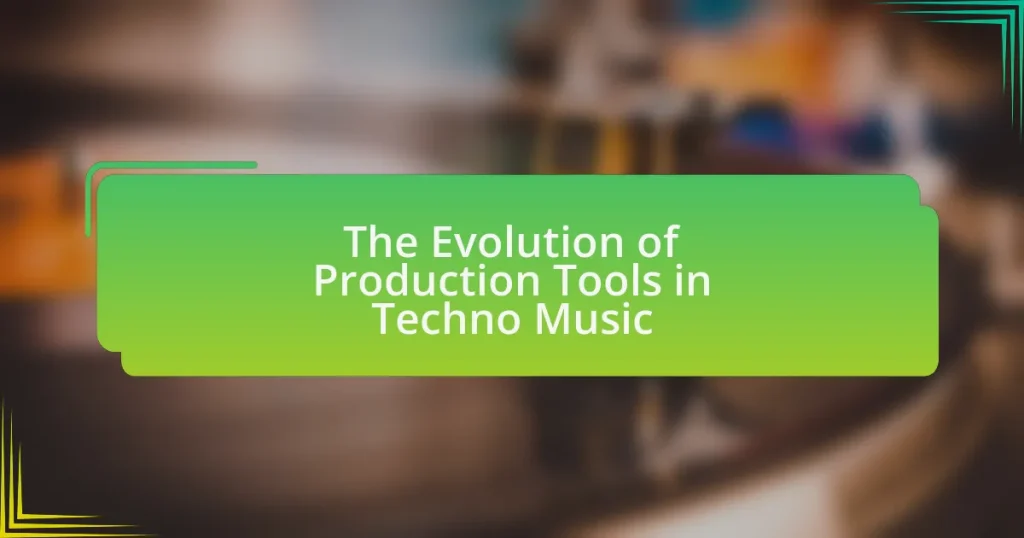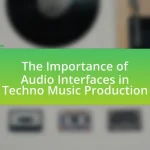The article examines the evolution of production tools in techno music, tracing their development from analog synthesizers and drum machines in the 1980s to contemporary digital audio workstations (DAWs) and software plugins. It highlights key milestones, such as the introduction of the Roland TR-808 and TB-303, and discusses how advancements in technology, including MIDI and digital production tools, have expanded creative possibilities for artists. The article also explores the impact of these tools on the sound and accessibility of techno music, emphasizing the importance of understanding this evolution for both producers and the genre’s ongoing development.
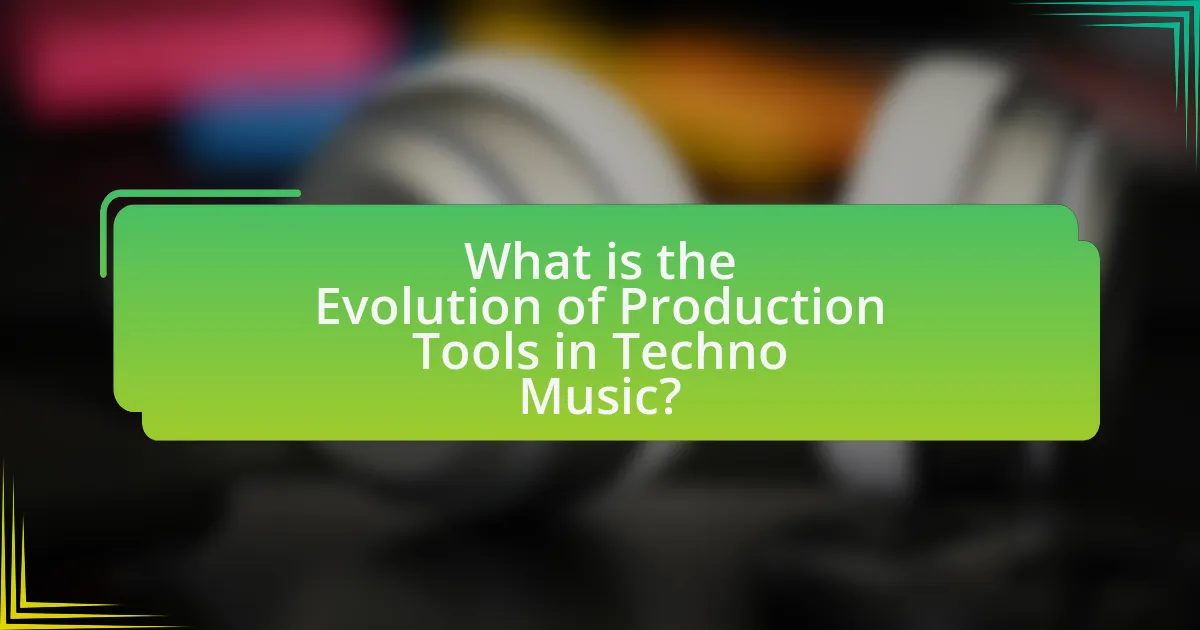
What is the Evolution of Production Tools in Techno Music?
The evolution of production tools in techno music has transitioned from analog synthesizers and drum machines in the 1980s to digital audio workstations (DAWs) and software plugins in the 21st century. Early techno producers relied on iconic hardware like the Roland TR-808 and TB-303, which defined the genre’s sound. As technology advanced, the introduction of MIDI and computer-based production allowed for greater flexibility and creativity, leading to the widespread adoption of DAWs such as Ableton Live and FL Studio. This shift enabled producers to manipulate sounds more intricately and integrate a vast array of virtual instruments and effects, significantly expanding the sonic palette available for techno music production.
How have production tools changed over the decades in techno music?
Production tools in techno music have evolved significantly from the 1980s to the present day, transitioning from analog synthesizers and drum machines to sophisticated digital audio workstations (DAWs) and software plugins. In the early days, artists relied on hardware like the Roland TR-808 and TB-303, which defined the sound of early techno. As technology advanced, the introduction of MIDI in the 1980s allowed for greater synchronization and control over multiple devices, enhancing creative possibilities.
By the 1990s, the rise of personal computers and software like Ableton Live and Logic Pro revolutionized music production, enabling artists to produce high-quality tracks from home studios. The 2000s saw the proliferation of virtual instruments and effects, allowing for a wider range of sounds and production techniques. Today, producers utilize a combination of hardware and software, including advanced sampling techniques and AI-driven tools, which further streamline the production process and expand creative horizons.
This progression reflects not only technological advancements but also shifts in artistic expression within the genre, showcasing how production tools have continually shaped the sound and accessibility of techno music.
What were the earliest production tools used in techno music?
The earliest production tools used in techno music included the Roland TR-808 drum machine, the Roland TB-303 bass synthesizer, and the Akai MPC series. The Roland TR-808, released in 1980, became iconic for its deep bass and distinctive snare sounds, shaping the rhythmic foundation of techno. The Roland TB-303, introduced in 1982, was initially designed for bassline creation but gained popularity for its squelchy sound, becoming a staple in techno tracks. The Akai MPC series, starting with the MPC60 in 1988, provided sampling capabilities that allowed producers to manipulate sounds creatively, further influencing the genre’s development. These tools were pivotal in establishing the sound and production techniques that define techno music.
How did the introduction of digital technology impact production tools?
The introduction of digital technology significantly transformed production tools in techno music by enhancing accessibility, efficiency, and creativity. Digital audio workstations (DAWs) replaced traditional hardware, allowing producers to create, edit, and mix music with greater precision and flexibility. For instance, software like Ableton Live and FL Studio enables real-time manipulation of sound, which was not possible with analog equipment. Additionally, the proliferation of virtual instruments and plugins expanded the sonic palette available to producers, facilitating innovative sound design. According to a study by the International Journal of Music Technology, the shift to digital tools has democratized music production, enabling a broader range of artists to participate in the genre.
Why is understanding the evolution of production tools important for techno music?
Understanding the evolution of production tools is crucial for techno music because it directly influences the genre’s sound, creativity, and accessibility. The development of synthesizers, drum machines, and digital audio workstations has shaped the sonic landscape of techno, allowing artists to experiment with new textures and rhythms. For instance, the introduction of the Roland TR-808 in the 1980s revolutionized electronic music production by providing distinctive drum sounds that became foundational in techno tracks. Additionally, advancements in software like Ableton Live have democratized music production, enabling a broader range of artists to create and innovate within the genre. This historical context highlights how production tools not only define the aesthetic of techno music but also expand its reach and evolution over time.
How does the evolution of tools influence the sound of techno music?
The evolution of tools significantly influences the sound of techno music by enabling new sonic possibilities and production techniques. As technology advances, artists gain access to more sophisticated synthesizers, drum machines, and digital audio workstations, which allow for greater experimentation and creativity. For instance, the introduction of the Roland TR-808 in the 1980s revolutionized the genre by providing distinctive bass and snare sounds that became foundational to techno. Additionally, the shift from analog to digital production tools in the 1990s expanded the range of sounds and effects available, leading to the emergence of sub-genres like minimal techno and ambient techno. This ongoing evolution continues to shape the genre, as contemporary tools like software synthesizers and plugins further enhance sound design capabilities, allowing artists to push the boundaries of techno music.
What role do production tools play in the creativity of techno artists?
Production tools are essential in shaping the creativity of techno artists by providing them with the means to experiment and innovate within their music. These tools, which include software synthesizers, digital audio workstations (DAWs), and hardware instruments, enable artists to manipulate sound in unique ways, facilitating the exploration of new sonic textures and rhythms. For instance, the use of DAWs like Ableton Live allows for intricate layering and real-time manipulation of sounds, which can lead to unexpected creative outcomes. Additionally, the evolution of production tools has historically influenced the genre; the introduction of MIDI in the 1980s revolutionized how artists composed and arranged music, expanding their creative possibilities. Thus, production tools not only serve as instruments but also as catalysts for artistic expression and innovation in techno music.
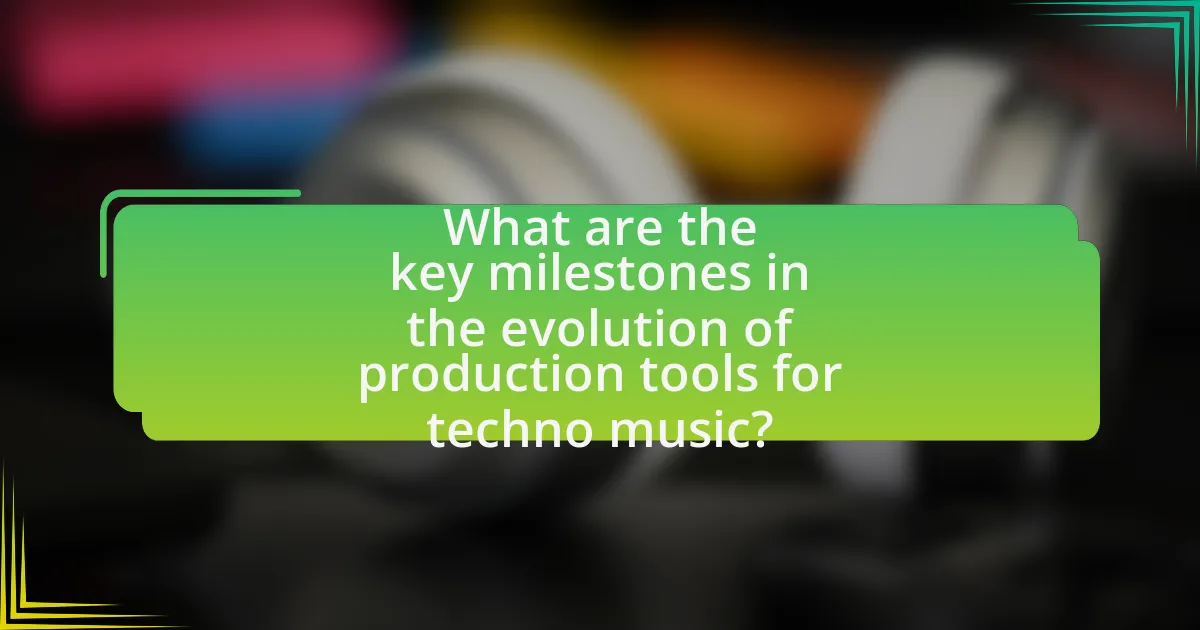
What are the key milestones in the evolution of production tools for techno music?
The key milestones in the evolution of production tools for techno music include the introduction of the Roland TR-808 drum machine in 1980, which revolutionized rhythm production with its distinctive sounds. In 1983, the release of the Roland TB-303 bass synthesizer further shaped the genre by providing a unique squelchy sound that became synonymous with acid techno. The development of MIDI technology in the early 1980s allowed for greater integration of electronic instruments, enabling more complex compositions. In the 1990s, software-based digital audio workstations (DAWs) like Ableton Live and FL Studio emerged, democratizing music production and allowing artists to create tracks on personal computers. The rise of virtual instruments and plugins in the 2000s expanded the sonic palette available to producers, facilitating innovative sound design. Each of these milestones significantly impacted the production landscape of techno music, shaping its evolution and accessibility.
What significant technological advancements have shaped production tools?
Significant technological advancements that have shaped production tools include the development of digital audio workstations (DAWs), synthesizers, and MIDI technology. DAWs, such as Ableton Live and Logic Pro, revolutionized music production by allowing users to record, edit, and mix audio digitally, enhancing workflow and creativity. The introduction of synthesizers, like the Moog and Roland TR-808, provided new sound possibilities and became staples in techno music, influencing its characteristic sound. MIDI technology enabled the communication between electronic instruments and computers, facilitating complex arrangements and live performances. These advancements collectively transformed the landscape of music production, making it more accessible and innovative.
How did synthesizers revolutionize techno music production?
Synthesizers revolutionized techno music production by enabling the creation of complex sounds and textures that were previously unattainable with traditional instruments. The introduction of synthesizers in the late 1970s and early 1980s allowed producers to manipulate sound waves electronically, leading to innovative compositions characterized by unique timbres and rhythms. For instance, the Roland TB-303 bass synthesizer became iconic for its distinctive squelchy sound, which defined the acid house subgenre of techno. Additionally, synthesizers facilitated the layering of multiple sounds, allowing for richer and more intricate arrangements, which became a hallmark of techno music. This technological advancement not only expanded the creative possibilities for artists but also contributed to the genre’s rapid evolution and widespread popularity in clubs and festivals worldwide.
What impact did software-based production tools have on the genre?
Software-based production tools significantly transformed the techno music genre by democratizing music creation and enabling greater experimentation. These tools, such as digital audio workstations (DAWs) like Ableton Live and FL Studio, allow artists to produce high-quality tracks from home studios, reducing the need for expensive studio time. This accessibility has led to an explosion of new artists and diverse sounds within the genre, as individuals can easily manipulate samples, synthesize sounds, and apply effects. The proliferation of software-based tools has also facilitated the rise of subgenres, as producers can quickly iterate on ideas and collaborate remotely, fostering innovation and creativity in techno music.
What are the major types of production tools used in techno music today?
The major types of production tools used in techno music today include digital audio workstations (DAWs), synthesizers, drum machines, and audio plugins. Digital audio workstations like Ableton Live and FL Studio serve as the primary platforms for composing, arranging, and mixing tracks. Synthesizers, both hardware and software, generate a wide range of sounds essential for creating the characteristic textures of techno. Drum machines, such as the Roland TR-909, provide iconic rhythmic patterns that define the genre. Additionally, audio plugins enhance sound design and mixing capabilities, offering effects and virtual instruments that expand creative possibilities. These tools collectively shape the production landscape of contemporary techno music.
What are the differences between hardware and software tools in techno production?
Hardware tools in techno production refer to physical devices such as synthesizers, drum machines, and audio interfaces, while software tools encompass digital applications and plugins used for music creation and editing. Hardware tools often provide tactile control and unique sound characteristics, which can enhance the creative process, whereas software tools offer flexibility, ease of use, and a vast array of sounds and effects that can be easily manipulated. For instance, iconic hardware synthesizers like the Roland TB-303 have distinct sonic qualities that are difficult to replicate in software, while software like Ableton Live allows for extensive editing and arrangement capabilities that hardware may not support.
How do modern DAWs (Digital Audio Workstations) facilitate techno music creation?
Modern DAWs (Digital Audio Workstations) facilitate techno music creation by providing an integrated platform for composing, recording, editing, and mixing music. These software applications offer a range of tools such as MIDI sequencing, audio manipulation, and virtual instruments, which are essential for producing the intricate rhythms and textures characteristic of techno. For instance, DAWs like Ableton Live and FL Studio allow users to create complex drum patterns and synth lines with ease, enabling rapid experimentation and iteration. Additionally, features like automation and effects processing enhance sound design capabilities, allowing producers to craft unique sonic landscapes. The accessibility of these tools has democratized music production, making it possible for a wider range of artists to create professional-quality techno tracks without the need for expensive hardware setups.
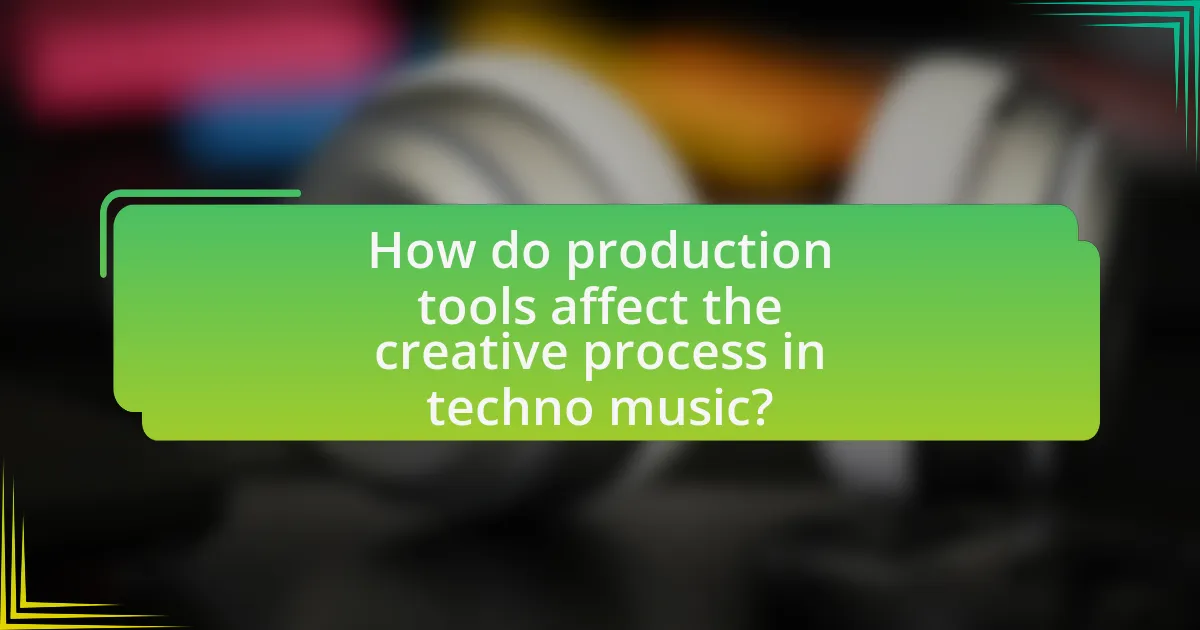
How do production tools affect the creative process in techno music?
Production tools significantly influence the creative process in techno music by enabling artists to experiment with sound design and composition. These tools, such as digital audio workstations (DAWs), synthesizers, and drum machines, provide musicians with a wide range of sonic possibilities that can inspire new ideas and facilitate innovative arrangements. For instance, the use of software like Ableton Live allows for real-time manipulation of audio, encouraging spontaneity and creativity during the production phase. Additionally, hardware synthesizers, like the Roland TB-303, have historically shaped the genre’s sound, leading to the development of iconic tracks and styles. The accessibility of these production tools has democratized music creation, allowing a broader range of artists to contribute to the techno genre, thus continuously evolving its creative landscape.
What are the common techniques used with production tools in techno music?
Common techniques used with production tools in techno music include layering, sampling, and automation. Layering involves combining multiple sound elements to create a richer texture, often utilizing synthesizers and drum machines to achieve complex rhythms and harmonies. Sampling allows producers to incorporate snippets of existing recordings, which can be manipulated to fit the techno aesthetic, often using tools like Ableton Live or FL Studio. Automation is employed to control various parameters over time, such as volume, effects, and filter settings, enhancing the dynamic range and movement within a track. These techniques are foundational in shaping the sound and structure of techno music, contributing to its distinctive and evolving character.
How do producers utilize sampling in their tracks?
Producers utilize sampling in their tracks by incorporating pre-recorded sounds or musical snippets to create new compositions. This technique allows them to blend various genres, evoke nostalgia, and enhance the overall texture of their music. For instance, in techno music, producers often sample drum loops, vocal snippets, or melodic phrases from older tracks, which can be manipulated through effects and editing to fit the modern sound. The use of sampling has been a significant aspect of music production since the 1980s, with artists like Derrick May and Kevin Saunderson pioneering its application in techno, demonstrating its effectiveness in creating innovative and engaging soundscapes.
What role does automation play in the production of techno music?
Automation plays a crucial role in the production of techno music by enabling precise control over various elements such as rhythm, melody, and effects. This technology allows producers to program intricate sequences and manipulate sound parameters with high accuracy, resulting in complex compositions that are characteristic of the genre. For instance, automation in digital audio workstations (DAWs) facilitates the adjustment of volume, panning, and effects over time, which enhances the dynamic range and texture of tracks. The use of automation has been integral since the late 1980s, when early electronic music production began to incorporate MIDI technology, allowing for more sophisticated arrangements and live performance capabilities.
How can producers choose the right production tools for their techno music?
Producers can choose the right production tools for their techno music by evaluating their specific sound preferences, workflow efficiency, and budget constraints. Identifying the desired sound characteristics, such as basslines, synth textures, and drum patterns, helps in selecting appropriate synthesizers, drum machines, and software. For instance, tools like Ableton Live and FL Studio are popular for their user-friendly interfaces and extensive libraries, which cater to techno’s rhythmic and melodic needs. Additionally, considering the integration of hardware and software can enhance creativity; many producers utilize analog synthesizers like the Roland TR-909 for authentic sounds. Research indicates that the choice of production tools significantly impacts the creative process, as highlighted in studies on music production workflows.
What factors should be considered when selecting production tools?
When selecting production tools, factors such as compatibility, functionality, user interface, and cost must be considered. Compatibility ensures that the tools work seamlessly with existing hardware and software, which is crucial for efficient workflow. Functionality refers to the features and capabilities of the tools, which should align with the specific needs of techno music production, such as sound design and sequencing. A user-friendly interface enhances productivity by allowing producers to navigate and utilize the tools effectively. Cost is also a significant factor, as it impacts the budget and overall investment in production equipment. These considerations are essential for optimizing the production process and achieving desired musical outcomes.
How can producers stay updated with the latest production tools and trends?
Producers can stay updated with the latest production tools and trends by actively engaging with industry resources such as online forums, social media groups, and professional networks. These platforms provide real-time discussions and insights into emerging technologies and techniques. Additionally, subscribing to industry publications and attending workshops or webinars can enhance knowledge about new tools and trends. Research indicates that 70% of music producers rely on online communities for updates, highlighting their importance in the industry.
What are some best practices for using production tools in techno music?
Best practices for using production tools in techno music include utilizing high-quality synthesizers, employing effective sound design techniques, and mastering the arrangement process. High-quality synthesizers, such as the Moog Sub 37 or the Roland TR-909, provide rich sound textures essential for the genre. Effective sound design techniques, like layering sounds and using modulation, enhance the depth and complexity of tracks. Mastering the arrangement process ensures that tracks maintain energy and flow, which is crucial in techno music, where repetitive structures are common. These practices are supported by the fact that many successful techno producers emphasize the importance of sound quality and arrangement in their production workflows.
How can producers effectively integrate new tools into their workflow?
Producers can effectively integrate new tools into their workflow by first assessing their current processes and identifying specific areas for improvement. This targeted approach allows producers to select tools that enhance efficiency or creativity, such as digital audio workstations or synthesizers tailored to techno music. Research indicates that producers who adopt a structured integration plan, which includes training and gradual implementation, experience a smoother transition and greater overall satisfaction with the new tools. For instance, a study by the International Journal of Music Technology found that producers who engaged in hands-on workshops reported a 30% increase in productivity when using new software.
What common mistakes should producers avoid when using production tools?
Producers should avoid over-reliance on presets when using production tools. This mistake can lead to a lack of originality in sound design, as many producers may end up using the same sounds, resulting in music that sounds generic. Additionally, failing to understand the tools’ functionalities can hinder creativity and efficiency; for instance, not utilizing automation features can limit dynamic expression in tracks. Lastly, neglecting to organize samples and projects can lead to confusion and wasted time during the production process, ultimately affecting productivity and the quality of the final output.
